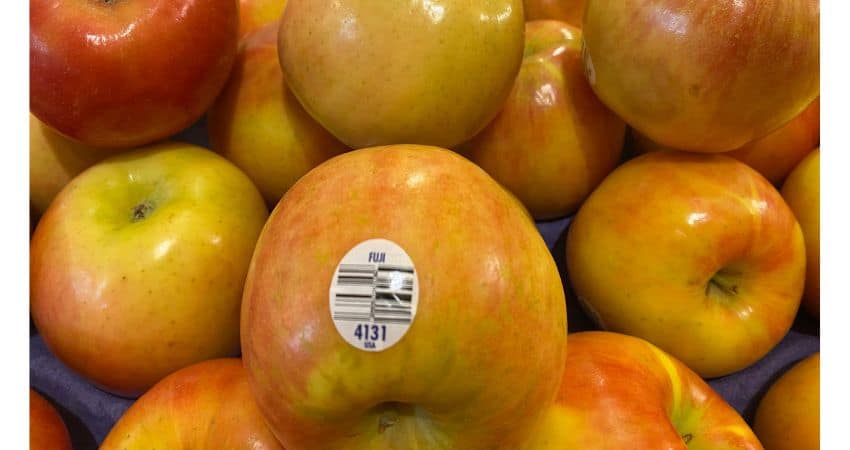Fuji Apple vs McIntosh – What’s The Difference?
Let’s take a look at the differences between Fuji Apples and McIntosh.
Fuji apples are large having a thick skin and dense flesh beneficial for cooking. McIntosh is smaller than Fuji with a thicker skin and juicier flesh beneficial for juice and cider. Fuji has a sweet taste and crispy texture while McIntosh taste more tart with a tender texture.
In this article, I will take a close look at the subtle and noticeable differences between these two varieties of apples.
Fuji Apple vs McIntosh – Origins
As a Certified Health Coach I often get asked about the topic of apples. For this reason, and because I eat an apple everyday myself, I have researched this topic in the past and present.

Where Do Fuji Apples Originate From?
The Fuji apple originated in Japan in the late 1930s, developed by researchers in the Tohoku Research Station in Fujisaki (hence the name Fuji).
While this apple was discovered in the 1930s, it only made it to the market and began being commercially produced in 1962.
The Fuji is a hybrid created to combine the best aspects of two popular varieties of American apples1. Those two are the Red Delicious and an older strain known as the Virginia Ralls Genet2.
Where Did The McIntosh Apple Originate?
The McIntosh has often been referred to as the national apple of Canada after being discovered in 1811 in Upper Canada (now called Ontario) by John McIntosh. He was taking a stroll in an overgrown part of his orchard. There, John found a young tree bearing the first harvest of what would be known as the McIntosh apple.
The actual origin of the apple cannot be pinned down because apples are not native to Canada. They were brought by French settlers in the 1600s and was around ever since3.
John and his family prized these apples greatly, but it wasn’t until two decades later the McIntosh made its way into the market.
In 1835, John’s son, Allan, began grafting the McIntosh into the roots of a winter-resistant apple tree, and the resultant hybrid was able to thrive in the cold weather of upper Canada. Allan began selling them where he lived and to markets in the northeastern part of the USA.
By 1870, the Mac was being produced commercially under the name “McIntosh Red,” and by 1900, it became the most popular apple in Canada and the northern part of America4.
Fuji vs McIntosh – Nutritional Value
| Fuji (One Cup) | McIntosh (One Cup) | |
| Calories | 69 | 57 |
| Carbohydrates | 17 g | 16 g |
| Fiber | 2.3 g | 3.5 g |
| Sugar | 13 g | 11 g |
| Potassium | 119 mg | 120 mg |
| Vitamin C | 2.9 mg | 3.4 mg |
As you can see in the table above, there is not much difference in nutritional value between the two apples5. While apples have a great reputation for being good for you, you may be wondering why after looking at the table.
The answer is in the apples’ skin which contains many antioxidants6. In addition, the skin contains half the fiber. Therefore, it’s wise to leave the skin on the apple, whether eating them whole or adding them to smoothies.
In fact, the apple’s antioxidants are so powerful, scientists have calculated it’s equal to more than 1,500 milligrams of vitamin C.
Fuji and McIntosh Apples – Taste, Texture and Size
Are Fuji apples sweet or tart?
Fuji apples have a sweet taste with a slight tartness. They have a crispy texture and a dense flesh with some juiciness.
Fuji apples are round with some possessing lopsided features. They are large apples with an average diameter of 75mm and bright red all over, with shades of yellow sometimes peaking through the skin7.
What is the flavor of McIntosh apples?
The flesh of the McIntosh apple taste sweet, juicy and tender yet firm and chewy. However, if you peel the apple and leave it alone for a few minutes, the flesh will instantly turn soft.
Unlike Fuji apples, the McIntosh has a thicker skin that can be peeled off to expose flesh often tinged in pink or green.
The McIntosh is a small to medium-sized apple, rounded in shape like the Fuji apples. The color of the apples depends on when it is picked. Early season McIntosh apples tend to be much greener, while the ripened fruit is red and tinged with green.

My Taste Test at Home
To conduct original research about taste, I decided to have a blind test test at home which included five people.
Each person, including myself, was given each apple at a time for one or two bites. Three out of five people chose the Fuji apple as having the better taste.
Fuji vs McIntosh Apples – Cooking
What are Fuji apples good for?
Fuji apples are good for apple based soups, roasts, pies, tarts, cakes and muffins. Their thick skin and dense flesh hold together well when cooked or baked. The steadiness of its texture allows for it to be used in meat-based recipes like pork chops, bacon, sausage and turkey roasts.
The Fuji has a consistency similar to potatoes and is often used as the filling for quiches or sandwiches. You can even get creative and mix this apple into a mashed potato dish, giving a sweet twist to the classic recipe.
This apple makes a great addition to fruit salads and can be mixed into rice or grated over breakfast preparations like oatmeal and pancakes.
Are McIntosh apples for baking or eating?
McIntosh apples can be used for eating raw, baking and cooked in a variety of recipes. However, the flesh of the McIntosh is delicate and breaks down quickly when cooked.
This characteristic of the McIntosh makes it the perfect apple for pie fillings and when slow-cooked, the Mac can be used to produce delectable sauces and chutneys.
When stirred into flour, McIntosh apples will lend a distinct sweetness to bread, cakes and cookies while keeping them soft and moist. This is so because of the apple’s water content.
Unlike the Fuji, the McIntosh tends to have a slightly tangy flavor, making it the perfect apple for juices and cider. Its sharp flavor makes it a popular pairing for certain varieties of cheese, including feta, gorgonzola and cheddar.
Fuji and McIntosh Apples – Climates
Where do McIntosh apple trees grow?
McIntosh apples are grown in New York, Canada and other area of the northeastern United States. They are specifically bred to withstand the cold which is why they are not grown in warm conditions or areas.
McIntosh apples are hard to find because they are available only in the fall and early winter. Their limited growing times make them sell very well in the winter months.
Where do Fuji apples grow best?
Fuji apples grow best in moderate climates without large fluctuations in temperatures but can adapt to most climates. They are mostly grown in the states of Michigan, Washington, New York, Pennsylvania and California.
Fuji apples can be grown at any time, so they are available throughout the year, with the peak season being late fall through early winter8.
Fuji vs McIntosh Apples – Storing
The best apples for storing a longer time are ones more tart and thick-skinned9. Fuji and McIntosh store similar to each other.
The best way to store Fuji apples is keeping them at a cool temperature between 30-35 degrees Fahrenheit in a dark place.
The refrigerator is the best place stored in the crisper drawer. The apples should be covered with a damp cloth or in a storage container with holes for venting.
McIntosh apples should be stored in the refrigerator crisper container. They should be kept away from other ethylene producing fruits and vegetables. It’s best to cover the apples with a damp paper towel or cloth.
If you have any questions to ask me about this article don’t hesitate to comment below or email us. You can find an email on our contact page.
Read Next – Another Apple vs Apple Article!
Empire vs Red Delicious Apples: The Ultimate Comparison
Fuji vs. Gala Apples – A Complete Comparison
Gala Vs Empire Apples – The Differences
Can Bananas and Apples be Stored Together?
- Wikipedia: Fuji (apple) [↩]
- North Carolina State: Malus domestic: Fuji Apple [↩]
- The Canadian Encyclopedia: McIntosh Apple [↩]
- Wikipedia: McIntosh (apple) [↩]
- Nutrition Value: Apples, fuji [↩]
- Nutrition Value: Mcintosh apples [↩]
- Washington State University: Fuji [↩]
- Yale University: Fuji Apple [↩]
- University of California: Apples: Safe Methods to Store, Preserve, and Enjoy [↩]
